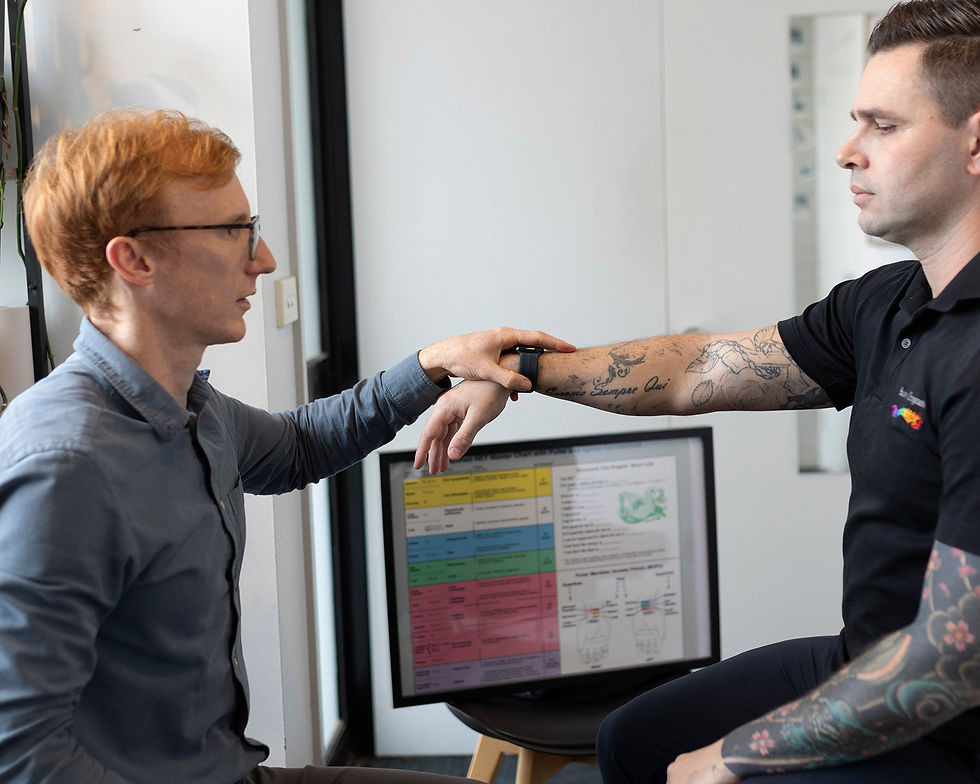How to help prevent Flattened Head Shape in newborn babies
- Dr Cynthia Collins

- Aug 1, 2024
- 4 min read
Updated: Nov 22, 2024
How to help prevent Flattened Head Shape in newborn babies
As chiropractors we often have concerned parents worried about changes or “flat patches” in the shape of their child’s head. These concerns are understandable and very justified. Previously considered as just aesthetically displeasing and something that will be fine once the baby’s hair grows over, plagiocephaly or brachycephaly aka “flat patches” is now taken more seriously. Studies are now showing links to possible developmental delays and issues later in life.
So, what causes this flattening and how do we help prevent it and manage it when it does occur? The skull of a newborn baby is very soft. Any constant pressure on the same spot of the head may cause the flattened area. The position in which the baby sleeps and plays can influence the shape of their head.
Key strategies to help prevent and manage the formation of flattened patches on your child’s head:
Play Time
- Supervised Tummy Time
Start with baby on your chest or lying over a rolled nappy (remove rolls for sleeping). Position the baby’s arms slightly forward and prop on elbows. This way it is easier for the baby to raise their head. Do this 3-4 times each day and gradually build up the time, e.g. try for a few minutes each nappy change etc.
- Place baby on alternate sides during playtime
Regularly change the position of the toys that your baby likes to look at, encourage baby to turn their head to either side when you talk or play with them
Day-to-day care
- Vary carrying positions. Alternate your arms or shoulders
- Alternate the arm you use to nurse the baby when feeding
- Avoid laying the baby on their back in car seats, bouncers or swings for prolonged periods of time (not more than 4 hours/day). Ensure baby’s head is not always turned to the same side.
Sleep Time
- Alternate baby’s head position when you put your baby to sleep (do not put baby to sleep on their side or tummy position, in order to prevent a flattened head spot)
- Put your baby to sleep at alternate ends of the cot or change the position of the cot in the room
Get your kids checked by a health practitioner with a focus on paediatric health. Ensuring that your child’s head and neck are able to move freely will allow for better movement and stability at play, day-to-day and at sleep time. Health professionals such as chiropractors and physiotherapists can assess and examine your little one for any dysfunction in movement of their head and neck, and give you further tips on how to manage the possible development of these flat patches.
If you have any questions regarding flat patches or your child’s health please contact Dr Cynthia Collins at Rainbow Chiropractic on (03) 5282 1200 or info@rainbowchiropractic.com.auHow to help prevent Flattened Head Shape in newborn babies
As chiropractors we often have concerned parents worried about changes or “flat patches” in the shape of their child’s head. These concerns are understandable and very justified. Previously considered as just aesthetically displeasing and something that will be fine once the baby’s hair grows over, plagiocephaly or brachycephaly aka “flat patches” is now taken more seriously. Studies are now showing links to possible developmental delays and issues later in life.
So, what causes this flattening and how do we help prevent it and manage it when it does occur? The skull of a newborn baby is very soft. Any constant pressure on the same spot of the head may cause the flattened area. The position in which the baby sleeps and plays can influence the shape of their head.
Key strategies to help prevent and manage the formation of flattened patches on your child’s head:
Play Time
- Supervised Tummy Time
Start with baby on your chest or lying over a rolled nappy (remove rolls for sleeping). Position the baby’s arms slightly forward and prop on elbows. This way it is easier for the baby to raise their head. Do this 3-4 times each day and gradually build up the time, e.g. try for a few minutes each nappy change etc.
- Place baby on alternate sides during playtime
Regularly change the position of the toys that your baby likes to look at, encourage baby to turn their head to either side when you talk or play with them
Day-to-day care
- Vary carrying positions. Alternate your arms or shoulders
- Alternate the arm you use to nurse the baby when feeding
- Avoid laying the baby on their back in car seats, bouncers or swings for prolonged periods of time (not more than 4 hours/day). Ensure baby’s head is not always turned to the same side.
Sleep Time
- Alternate baby’s head position when you put your baby to sleep (do not put baby to sleep on their side or tummy position, in order to prevent a flattened head spot)
- Put your baby to sleep at alternate ends of the cot or change the position of the cot in the room
Get your kids checked by a health practitioner with a focus on paediatric health. Ensuring that your child’s head and neck are able to move freely will allow for better movement and stability at play, day-to-day and at sleep time. Health professionals such as chiropractors and physiotherapists can assess and examine your little one for any dysfunction in movement of their head and neck, and give you further tips on how to manage the possible development of these flat patches.
If you have any questions regarding flat patches or your child’s health please contact Dr Cynthia Collins at Rainbow Chiropractic on (03) 5282 1200 or info@rainbowchiropractic.com.au





Comments